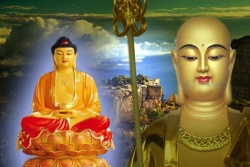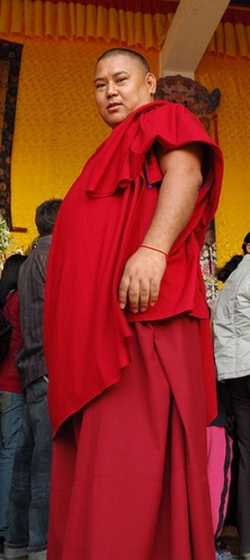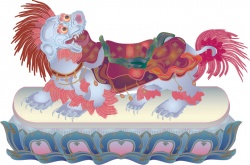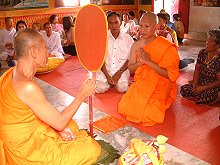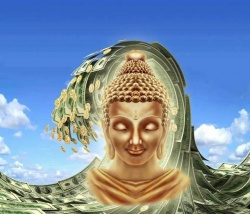Sacred Place, Perception, and the Treasure Tradition
Sacred Place, Perception, and the Treasure Tradition
Out of the various Buddhist operations that were present on the Tibetan plateau during the Tibetan Renaissance, the concept of sacred place probably figured most prominently in the treasure (gter ma) movement.
The logic seems rather straightforward: without a place to conceal the treasure, there would be no treasure, and in turn, without a treasure, there would be no treasure tradition.
Yet, a concept that is seemingly as clear-cut as the hiding place for a treasure is actually treated very differently by different thinkers.
If we examine the way in which sacred place within the context of the treasure tradition is perceived by Dudjom Rinpoche, Gö Lotsawa, and Ronald Davidson, we see that the very concept of “sacred place” is not only perceived differently, but can also be used to achieve very different ends.
Dudjom Rinpoche (1904-87), the late supreme head of the Nyingma tradition of Tibetan Buddhism, interprets sacred space within the treasure tradition both literally and metaphorically.
In addition to the literal “earth treasures” such as sacred images, objects, and texts that are hidden in such places as the beams and pillars of ancient Tibetan temples, caves, and holes in the ground, Dudjom Rinpoche and the Nyingma tradition speak of the more metaphorically inclined “mind treasure.”
These mind treasures are hidden in the mind streams of spiritually advanced individuals and are revealed as a vision of a Buddha or bodhisattva giving the individual spiritual instructions.
What is striking about the mind treasures is the metaphorical treatment of sacred space: the mind is a place from which “one hundred thousand doctrinal treasures will pour forth” if one has “confidence of certainty with respect to ultimate meaning” (748).
The metaphoric treatment of sacred space not only points to the aesthetic and creative tendencies of the Nyingma school, but also emphasizes a doctrinal point:
spiritually enlightened individuals continually hear the sound of the Buddha’s doctrine “From birds and from trees, /From all the light rays and even from the sky” (747).
In very much same way as Nagarjuna’s famous phrase “nirvana is samsara,” the concept of mind as place in the Nyingma school articulates that enlightenment is simply the world correctly perceived.
Dudjom Rinpoche’s discussion of sacred place in the context of the treasure tradition not only elegantly articulates a key Mahayana doctrine, but also attests to the creative and aesthetic inclinations of the Nyingma school.
In contrast, Gö Lotsawa (1392-1481), ever the historian, is much more literal in his discussion of sacred place within the treasure tradition.
Mentions of the treasure tradition in the Blue Annals are brief and rare (with the exception of the section on the Seminal Heart in the third chapter), but when Gö Lotsawa mentions the concealment or discovery of a treasure, he is sure to specify the precise geographical location.
For example, he specifies that Cetsun Senge Wangchuk (lce btsun seng ge dbang phyug) hides treasures in U Yug, Langdro Chepatag, and Jal gyi phu, and that Zhang Trashi Dorje (zhang bkra shis rdo rje) discovers Vimalamitra’s treasures at Chimpu (Blue Annals 191, 193).
In addition, he Gö Lotsawa puts greater emphasis on the hermitages and physical edifices built by treasure revealers than the treasures that they reveal.
If we consider the fact that Gö Lotsawa was writing this work in a time when the Tibetan national identity was being negotiated and solidified, it comes to no surprise that he is most interested in establishing the narratives associated with specific locations as well as the physical monuments that were built on the Tibetan landscape by important personalities.
If people develop their identities by relating to the places that they inhabit, and familiar landscapes become “the geography of the human imagination” (Sheldrake 14), Gö Lotsawa is interested in using sacred place as a way to articulate the mental geography of the Tibetan national and religious identity within himself and his readers.
This identity is concretized by actual religious edifices in the landscape.
Ever the historian, Gö Lotsawa is more interested in the concrete facts of the treasure tradition, such as the place in which treasures are discovered, rather than the soteriological implications or aesthetic considerations that are associated with it.
Finally, Ronald Davidson’s discusses sacred place in a way that differs greatly form the above two thinkers.
In his book Tibetan Renaissance: Tantric Buddhism in the Rebirth of Tibetan Culture, sacred place figures in his discussion of the treasure tradition in two ways. Firstly, Davidson argues that early terma descriptions are in fact based on descriptions of the temples and tombs of the Imperial Kings (224).
In effect, the sacred hiding place of the treasure represents a refashioning of the sacred imperial tomb that housed the remains of the deceased emperor.
Secondly, Davidson points out that treasures revealed throughout the Tibetan plateau “validated the familiar cultural landscape” making Tibet the “authentic ground of the Buddha’s enlightened activity” and an “active partner in the Buddhist cosmos (231).
Among other things, these two points reveal a key aspect of Davidson’s intellectual project: Davidson is interested in uncovering and analyzing narratives behind objects and concepts.
Primarily a textual scholar fascinated by the power of discourse and narrative to mold and shape the imaginations of a people, Davidson’s scholarship is primarily a scholarship of discourse.
According to Davidson, discourse was powerful enough to initiate “a process that begins with the textualization of Songsten Gampo’s self ends with the landscape of Tibet inscribed as the self of the emperors” (243).
Indeed, Davidson is interested in sacred place, but more so, he is interested in the discourses that inform, shape, mold, and underlie such sacred places.
Throughout this essay, I have examined the various ways in which sacred place in the context of the treasure tradition is viewed across different times and places.
While Dudjom Rinpoche views sacred place in the treasure tradition from a creative standpoint, Gö Lotsawa views sacred place very literally.
Ronald Davidson gives us a third view of sacred place in the treasure tradition, examining it in terms of the power of discourse on our mindsets.
Thus, a phenomenon that seems as straight-forward as the hiding place of a treasure actually takes on many different forms when seen through the eyes of different people, adding an additional layer of complexity to the already fascinating tradition of terma. Sources
Davidson, Ronald. Tibetan Renaissance: Tantric Buddhism in the Rebirth of Tibetan Culture. New York: Columbia University Press, 2005.
Dudjom Rinpoche. The Nyingma School of Tibetan Buddhism: Its Fundamentals & History. Translated and edited Gyurme Dorje and Matthew Kapstein. Boston: Wisdom Publications, 1991.
Gö lo tsa ba gzon nu dpal]]. The Blue Annals. Trans. George N. Roerich. Calcutta: Royal Asiatic Society of Bengal, 1949.
Sheldrake, Phillip. Spaces for the Sacred: Place, Memory, and Identity. Baltimore: Johns Hopkins University Press, 2001.
